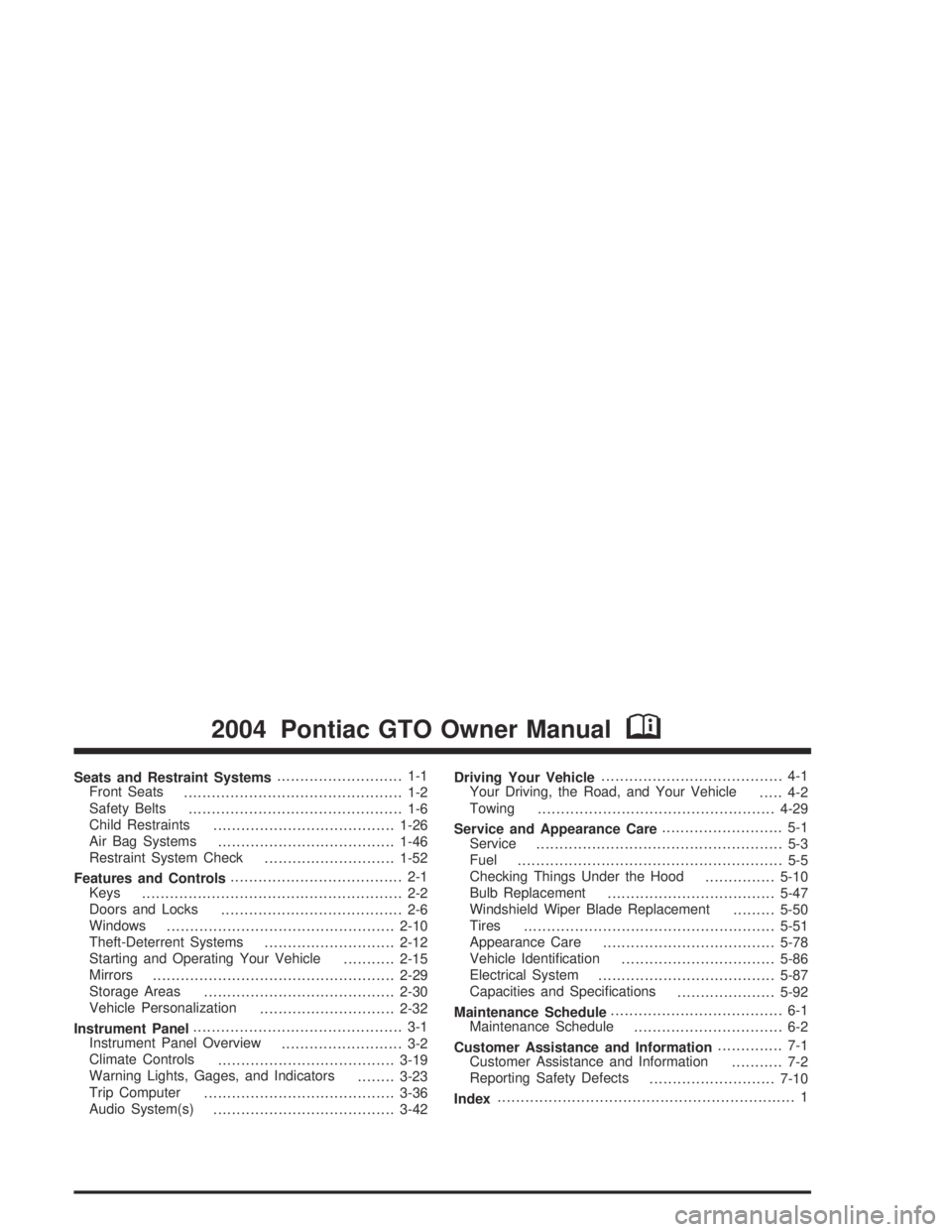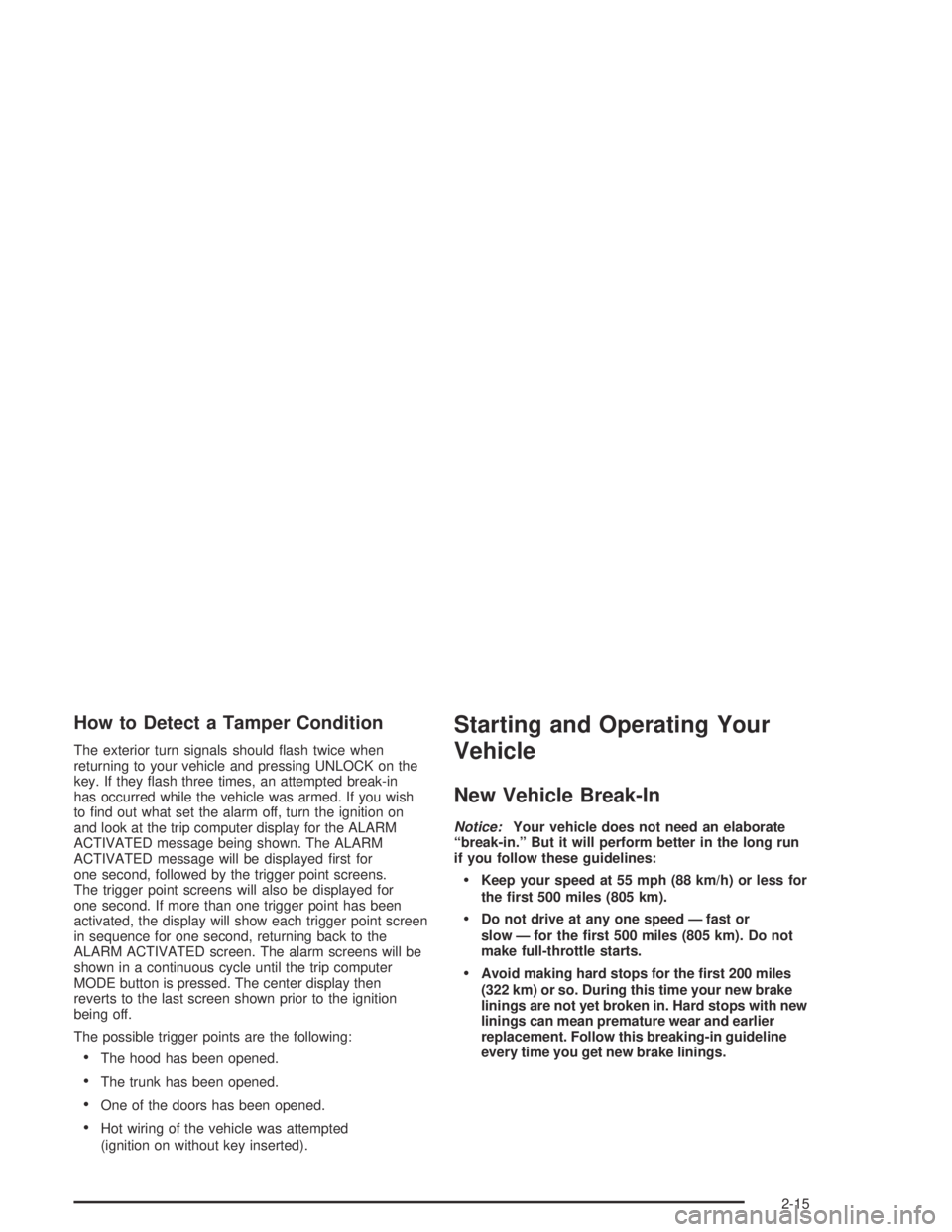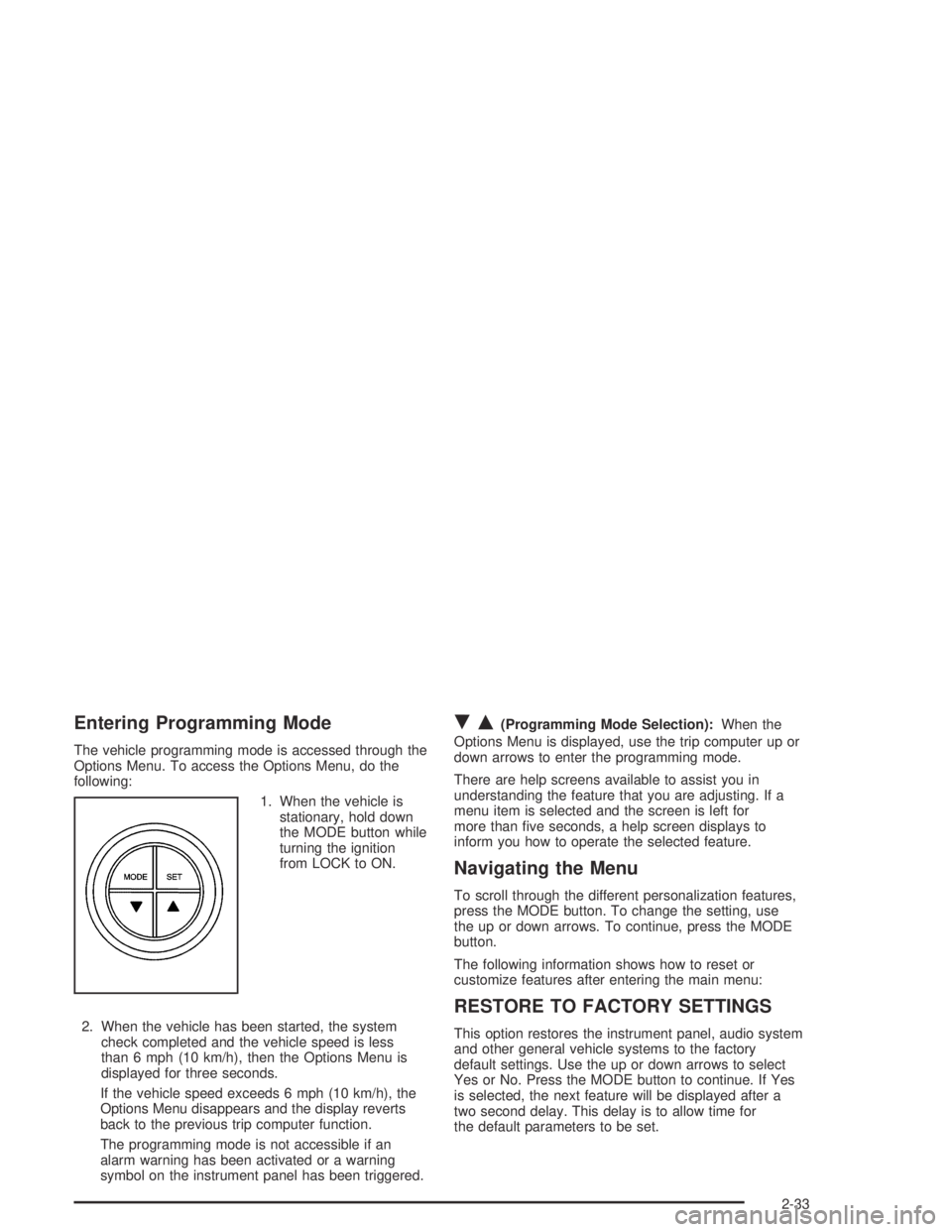2004 PONTIAC GTO trip computer
[x] Cancel search: trip computerPage 1 of 326

Seats and Restraint Systems........................... 1-1
Front Seats
............................................... 1-2
Safety Belts
.............................................. 1-6
Child Restraints
.......................................1-26
Air Bag Systems
......................................1-46
Restraint System Check
............................1-52
Features and Controls..................................... 2-1
Keys
........................................................ 2-2
Doors and Locks
....................................... 2-6
Windows
.................................................2-10
Theft-Deterrent Systems
............................2-12
Starting and Operating Your Vehicle
...........2-15
Mirrors
....................................................2-29
Storage Areas
.........................................2-30
Vehicle Personalization
.............................2-32
Instrument Panel............................................. 3-1
Instrument Panel Overview
.......................... 3-2
Climate Controls
......................................3-19
Warning Lights, Gages, and Indicators
........3-23
Trip Computer
.........................................3-36
Audio System(s)
.......................................3-42Driving Your Vehicle....................................... 4-1
Your Driving, the Road, and Your Vehicle
..... 4-2
Towing
...................................................4-29
Service and Appearance Care.......................... 5-1
Service
..................................................... 5-3
Fuel
......................................................... 5-5
Checking Things Under the Hood
...............5-10
Bulb Replacement
....................................5-47
Windshield Wiper Blade Replacement
.........5-50
Tires
......................................................5-51
Appearance Care
.....................................5-78
Vehicle Identification
.................................5-86
Electrical System
......................................5-87
Capacities and Specifications
.....................5-92
Maintenance Schedule..................................... 6-1
Maintenance Schedule
................................ 6-2
Customer Assistance and Information.............. 7-1
Customer Assistance and Information
........... 7-2
Reporting Safety Defects
...........................7-10
Index................................................................ 1
2004 Pontiac GTO Owner ManualM
Page 75 of 326

How to Detect a Tamper Condition
The exterior turn signals should flash twice when
returning to your vehicle and pressing UNLOCK on the
key. If they flash three times, an attempted break-in
has occurred while the vehicle was armed. If you wish
to find out what set the alarm off, turn the ignition on
and look at the trip computer display for the ALARM
ACTIVATED message being shown. The ALARM
ACTIVATED message will be displayed first for
one second, followed by the trigger point screens.
The trigger point screens will also be displayed for
one second. If more than one trigger point has been
activated, the display will show each trigger point screen
in sequence for one second, returning back to the
ALARM ACTIVATED screen. The alarm screens will be
shown in a continuous cycle until the trip computer
MODE button is pressed. The center display then
reverts to the last screen shown prior to the ignition
being off.
The possible trigger points are the following:
•The hood has been opened.
•The trunk has been opened.
•One of the doors has been opened.
•Hot wiring of the vehicle was attempted
(ignition on without key inserted).
Starting and Operating Your
Vehicle
New Vehicle Break-In
Notice:Your vehicle does not need an elaborate
“break-in.” But it will perform better in the long run
if you follow these guidelines:
Keep your speed at 55 mph (88 km/h) or less for
the �rst 500 miles (805 km).
Do not drive at any one speed — fast or
slow — for the �rst 500 miles (805 km). Do not
make full-throttle starts.
Avoid making hard stops for the �rst 200 miles
(322 km) or so. During this time your new brake
linings are not yet broken in. Hard stops with new
linings can mean premature wear and earlier
replacement. Follow this breaking-in guideline
every time you get new brake linings.
2-15
Page 92 of 326

Vehicle Personalization
Vehicle Personalization mode enables the driver to
customize some of the vehicle features using the trip
computer switch and instrument panel center display.
Only features that are equipped on the vehicle will
be displayed.
The following list shows features that can be reset or
customized.
•Restore To Factory Settings
•Underspeed Chime
•Distance To Arrival Display
•Arrival Default
•Trip Computer A and B
•Stop Watch
•Rest Reminder
•Digital Speedometer
•Radio Display
•Confirmation Beeps
•Speed Dependent Volume
•Audio Distortion Limiter
•Headlights Off Delay Time
•Headlights Approach Time
•Auto Headlights Sensitivity
•Courtesy Lamp Timeout
•Ignition Off Courtesy Lamp
•Two Stage Unlock
•Auto Lock In Drive (Automatic Transmission Only)
•Door Lock Indication
2-32
Page 93 of 326

Entering Programming Mode
The vehicle programming mode is accessed through the
Options Menu. To access the Options Menu, do the
following:
1. When the vehicle is
stationary, hold down
the MODE button while
turning the ignition
from LOCK to ON.
2. When the vehicle has been started, the system
check completed and the vehicle speed is less
than 6 mph (10 km/h), then the Options Menu is
displayed for three seconds.
If the vehicle speed exceeds 6 mph (10 km/h), the
Options Menu disappears and the display reverts
back to the previous trip computer function.
The programming mode is not accessible if an
alarm warning has been activated or a warning
symbol on the instrument panel has been triggered.
RQ(Programming Mode Selection):When the
Options Menu is displayed, use the trip computer up or
down arrows to enter the programming mode.
There are help screens available to assist you in
understanding the feature that you are adjusting. If a
menu item is selected and the screen is left for
more than five seconds, a help screen displays to
inform you how to operate the selected feature.
Navigating the Menu
To scroll through the different personalization features,
press the MODE button. To change the setting, use
the up or down arrows. To continue, press the MODE
button.
The following information shows how to reset or
customize features after entering the main menu:
RESTORE TO FACTORY SETTINGS
This option restores the instrument panel, audio system
and other general vehicle systems to the factory
default settings. Use the up or down arrows to select
Yes or No. Press the MODE button to continue. If Yes
is selected, the next feature will be displayed after a
two second delay. This delay is to allow time for
the default parameters to be set.
2-33
Page 94 of 326

UNDERSPEED CHIME
This option is used to enable or disable the underspeed
chime. Overspeed provides a chime when your
travelling speed exceeds the overspeed chosen value,
whereas underspeed provides an additional chime
to indicate when your travelling speed again drops below
the overspeed. Use the up or down arrows to select
Yes or No. If Yes is selected, the underspeed chime is
activated. Press the MODE button to continue. The
default selection is No.
DIST TO ARRIVAL DISPLAY
This option is used to enable or /disable the Time to
Arrival/Distance to Arrival/Remaining Fuel set of
displays. Use the up or down arrows to select Yes or
No. If Yes is selected, the Time to Arrival/Distance
to Arrival/Remaining Fuel set of displays is activated.
Press the MODE button to continue. The default
selection is No.
ARRIVAL DEFAULT
The Distance to Arrival, can be reset, when not in
personalization mode, by pressing the SET button for
less than two seconds. The distance resets to 300 miles
(500 km), which is the default setting. When in
personalization mode, the default setting can be altered
up or down with the up or down arrows. When correct,
press the MODE button to continue.
TRIP COMPUTERA&B
This option is used to select either one or two Trip
Time/Trip Distance/Fuel Used set of displays. Use
the up or down arrows to select Trip A or TripA&B.
Press the MODE button to continue. The default
selection is Trip A.
STOP WATCH
This option is used to enable or disable the Stop Watch
display. Use the up or down arrows to select Yes or
No. If Yes is selected, the Stop Watch display is
activated. Press the MODE button to continue. The
default selection is No.
REST REMINDER
This option is to alert the driver that they may have
been travelling for too long without a break. Use the
up or down arrows to select No or Yes, the default is Off.
Press the MODE button to continue.
DIGITAL SPEEDO
This option allows you to turn on a digital speedometer
that will display on the center display. Use the up or
down arrows to select Yes or No. The default selection
is Yes. Press MODE to continue.
2-34
Page 97 of 326

AUTO LOCK IN DRIVE (Automatic
Transmission Only)
This option is used to enable or disable the automatic
door locking when in Drive function. Use the up or down
arrows to select Yes or No. If Yes is selected, the
Auto Lock In Drive function is activated, the default is
No. Press the MODE button to continue. SeeDoor
Locks on page 2-6.
DOOR LOCK INDICATION
This option is used to select the type of indication
provided to the driver upon locking and unlocking the
vehicle’s doors. Use the up or down arrows to select
Indicators or Indicators & Horn, the default is Indicators.
Press the MODE button to continue.
Exiting Programming Mode
To exit, do one of the following:
•Press the MODE button to scroll through to the exit
screen.
•Drive the vehicle at more than 6 mph (10 km/h).
•Switch the ignition off if vehicle is stopped.
EXIT OPTIONS MENU
This option is used to either exit personalization mode
options menu or to return to the start of the options
menu. Use the up or down arrows to select Yes or No.
If Yes is selected, the trip computer exits calibration
mode and returns to the previous trip computer display.
If No is selected, the menu jumps back to the start of
the options menu, RESTORE TO FACTORY SETTINGS
display. Press the MODE button to continue.
2-37
Page 99 of 326

Instrument Panel Overview...............................3-2
Hazard Warning Flashers................................3-4
Other Warning Devices...................................3-4
Horn.............................................................3-4
Tilt Wheel.....................................................3-5
Turn Signal/Multifunction Lever.........................3-5
Exterior Lamps.............................................3-12
Interior Lamps..............................................3-15
Accessory Power Outlets...............................3-17
Ashtrays and Cigarette Lighter........................3-18
Climate Controls............................................3-19
Climate Control System.................................3-19
Outlet Adjustment.........................................3-22
Warning Lights, Gages, and Indicators............3-23
Instrument Panel Cluster................................3-24
Speedometer...............................................3-25
Tachometer.................................................3-25
Safety Belt Reminder Light.............................3-25
Air Bag Readiness Light................................3-26
Charging System Light..................................3-27
Brake System Warning Light..........................3-27Anti-Lock Brake System Warning Light.............3-28
Engine Coolant Temperature Gage..................3-28
Malfunction Indicator Lamp.............................3-29
Oil Pressure Light.........................................3-32
Change Engine Oil Light................................3-33
Security Light...............................................3-33
Fog Lamp Light............................................3-33
Highbeam On Light.......................................3-33
Daytime Running Lamps Indicator Light...........3-34
Service Vehicle Soon Light............................3-34
Fuel Gage...................................................3-35
Trip Computer................................................3-36
Audio System(s).............................................3-42
Setting the Time...........................................3-42
Radio with Six-Disc CD.................................3-43
Theft-Deterrent Feature..................................3-52
Audio Steering Wheel Controls.......................3-53
Radio Reception...........................................3-54
Care of Your CDs.........................................3-54
Care of Your CD Player................................3-54
Backglass Antenna.......................................3-55
Section 3 Instrument Panel
3-1
Page 101 of 326

The main components of the instrument panel are the following:
A. Side Outlets. SeeOutlet Adjustment on page 3-22.
B. Headlamps Dial. SeeExterior Lamps on page 3-12.
C. Instrument Panel Cluster. SeeInstrument Panel
Cluster on page 3-24.
D. Windshield Wiper Lever. See “Windshield Wipers”
underTurn Signal/Multifunction Lever on page 3-5.
E. Trip Computer Control. SeeTrip Computer on
page 3-36.
F. Outlets. SeeOutlet Adjustment on page 3-22.
G. Hazard Warning Lights. SeeHazard Warning
Flashers on page 3-4.
H. Sunlight Sensor. See “Automatic Headlamp System”
underExterior Lamps on page 3-12.
I. Climate Controls. SeeClimate Control System on
page 3-19.
J. Audio System Controls. SeeAudio System(s) on
page 3-42.
K. Passenger’s Air Bag. SeeWhere Are the Air Bags?
on page 1-48.L. Cruise Control Lever. See “Cruise Control” under
Turn Signal/Multifunction Lever on page 3-5.
M. Audio Steering Wheel Controls. SeeAudio Steering
Wheel Controls on page 3-53.
N. Driver’s Air Bag. SeeWhere Are the Air Bags? on
page 1-48.
O. Tilt Wheel. SeeTilt Wheel on page 3-5.
P. Horn. SeeHorn on page 3-4.
Q. Ignition Switch. SeeIgnition Positions on page 2-16.
R. Shift Lever. SeeShifting Into Park (P) on page 2-24.
S. Cupholders. SeeCupholder(s) on page 2-31.
T. Power Window Switches. SeePower Windows on
page 2-11.
U. Parking Brake. SeeParking Brake on page 2-23.
V. Glovebox. SeeGlove Box on page 2-30.
3-3